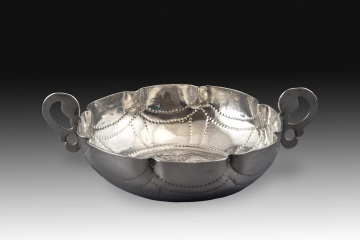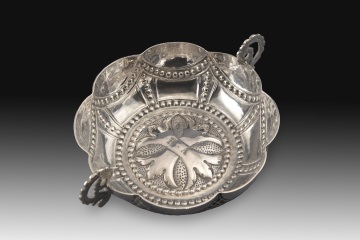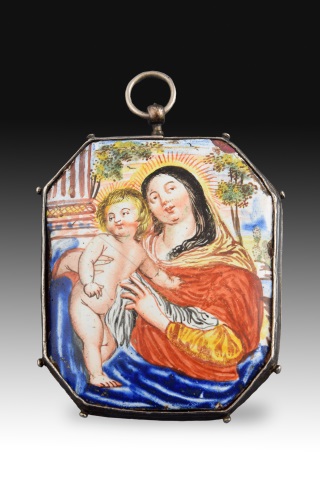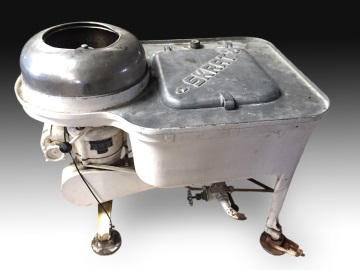
-
Toiletry bag. 19th century. Tortoiseshell, metal, glass. Rectangular case with a hinged lid made of tortoiseshell decorated with fine inlaid plant and floral elements on its sides, containing a toiletry bag set composed of various feminine toiletries and personal items (a small perfume bottle, scissors, a thimble, etc.), with a space designed for each of these utensils.
· Size: 6x3x8 cms.
ANTIQUES
MISCELLANEUS;OTHER OBJECTS
Ref.: Z6854
-

Catavinos or quaking glass. Silver. 18th century. Without contrast marks. Vessel known as catavinos or tembladera with two flat, closed “S” shaped handles and a line of “bites” (gallon-shaped shapes) highlighted by bands of dots that move to the inside of the piece. The bottom has a star shape (leaving smooth and with a shiny finish some stripes forming a Maltese Cross, and combining in the rest areas in the same finish with others in diamond-shaped lustre with dots). The bernegales and tembladeras with mortise-shaped pieces were frequent pieces in Spanish silverwork in the 17th century, usually being relegated to centres of somewhat less importance in the 18th century. Compare this with pieces such as the silver bernegal from the last third of the 17th century in the Lázaro Galdiano Museum (perhaps from the Portuguese school; inventory 3916), or the one dated between 1640 and 1665 from the same museum (inventory 3910), or the one by José Jiménez de Illescas (inventory 3915, dated 1715-1725) in the same institution. Weight: 83 gr.
· Size: 14,5x11x3 cms.
ANTIQUES
MISCELLANEUS;SILVER
Ref.: ZE192
-

Catavinos or quaking glass. Silver. 18th century. Without hallmarks. With ownership initials. Vessel known as a catavinos or tembladera with two curved flat handles decorated with simplified plant elements, and a line of morsels (gallon-shaped shapes) on the edge enhanced by bands of sunken dots that remain in relief on the inside of the piece, where they extend and frame the decoration on the bottom. In this area there is a florentine Greek cross in a smooth shiny finish with the letters “RA” engraved (initials of the property), highlighted on a dotted background. The bernegales and tembladeras with mortise-shaped pieces were frequent pieces in Spanish silverwork in the 17th century, usually being relegated to centres of somewhat less importance in the 18th century. Compare this with pieces such as the silver bernegal from the last third of the 17th century in the Lázaro Galdiano Museum (perhaps from the Portuguese school; inventory 3916), or the one dated between 1640 and 1665 from the same museum (inventory 3910), or the one by José Jiménez de Illescas (inventory 3915, dated 1715-1725) in the same institution. Weight: 94 gr.
· Size: 13,5x10,5x4,5 cms
ANTIQUES
MISCELLANEUS;SILVER
Ref.: ZE193
-
Catavinos or quaking glass. Silver. 17th century. Without contrast marks. Vessel known as a catavinos or tembladera with two flat, closed “S”-shaped handles (with simplified plant decoration) and a line of “bites” (gallon-shaped shapes) highlighted with bands of dots. On the bottom, inside, there is an eight-petaled flower engraved with a cross inside. The bernegales and tembladeras with mortise-shaped pieces were frequent pieces in Spanish silverwork in the 17th century, usually being relegated to centres of somewhat less importance in the 18th century. Compare this with pieces such as the silver bernegal from the last third of the 17th century in the Lázaro Galdiano Museum (perhaps from the Portuguese school; inventory 3916), or the one dated between 1640 and 1665 from the same museum (inventory 3910), or the one by José Jiménez de Illescas (inventory 3915, dated 1715-1725) in the same institution. Weight: 96 gr.
· Size: 15x10,5x4,5 cms.
ANTIQUES
MISCELLANEUS;SILVER
Ref.: ZE195
-

Reliquary pendant. Silver, enamel, textile. 17th century. A large polygonal pendant with a silver frame in its colour decorated with small pearls of the same material located in the corners of the edge, which has a ring at the top so that it can be hung or carried. One of its fronts has a textile background under a sheet of transparent glass, probably designed to contain relics. The other has a brightly coloured enamel showing the Virgin Mary in three-quarters, with the naked Child Jesus in her arms and both figures cut out against a landscape background with classicist architectural elements (a column with a fluted shaft on a pedestal, with mouldings) and details of a natural landscape (thus linking the moment with the Rest on the Flight into Egypt; compare, also, with works such as the Virgin and Child by Anton van Dyck from the Cerralbo Museum in Madrid or the oil painting from The Walters Art Museum, or the engraving by Paulus Pontius following Van Dyck's models - where the elements coincide in arrangement with those of the medallion -, for example). This type of jewellery has always had great value, both for the materials used and for its religious content. Despite this (or perhaps because of this same appreciation) there are not many examples of quality and in good condition, and it is possible to find them only in important private collections and in outstanding museums such as the Fundación Valencia de Don Juan in Madrid, the Museo Nacional de Artes Decorativas in the same city, etc., or old religious centres such as the Convent of the Descalzas Reales in Madrid.
· Size: 6,5x0.5x8 cms.
ANTIQUES
MISCELLANEUS;JEWELRY
Ref.: ZF0399
-

Washing machine. Metal, etc. SKRAT, model P-7, Leonard Ryznar, circa 1945. Metal washing machine with an electric motor that would drive a circular container (which moves the clothes, a “drum”), with a water inlet at the bottom to the right and with several valves and levers, as well as four circular base legs. to better support the ground and prevent, as far as possible, the machine from moving when it was in operation. Leonard Ryznar (or Rýznar) was the founder of the Skrat company, which made several models similar to the present one, very popular among those who could afford them in certain areas of Europe in the 20th century. As indicated on the aircraft itself, it is the P-7 model, produced around 1945. Towards the beginning of the 19th century, several “machines” were developed for washing clothes, consisting of a wooden box in which the clothes were placed and a manually operated system that moved them. Another variant was those that had a drum in which the clothes were pressed. clothes to wring them out. Electric washing machines were not created until the beginning of the 20th century (these appliances were already being advertised in the United States in 1904; apparently, the first one in Europe appeared somewhat later), becoming a mass appliance from the end of the 1900s onwards. from the 1940s to the early 1950s, and in Western Europe developed into an everyday appliance from about 1960.
· Size: 96x64x82 cms.
DECORATIVE ANTIQUES
MISCELLANEUS
Ref.: ZF0413
-
Low table, Dancer. Bronze, glass. 20th century. Glass defect. Low table with a transparent oval glass top, supported by a bronze female figure of a dancer in a dancing pose. The figure is inspired by 19th-century models derived from the French school, specifically works by Moreau. Weight with glass: 103 kg
· Size: 120x79x82 cms. vidrio: 82x122x1.5 cms.
DECORATIVE ANTIQUES
FURNITURE
Ref.: ZF1327
-
Pitcher with tray. Silver (915). Spain, 20th century. With contrast markings. A pitcher and tray made of silver in its natural color; the pitcher features a decoration of vines and grapes on the handle, and the tray has a rim in the style common in antique Spanish silverware. Hallmarks identify it as a 20th-century Spanish work, by Montejo silversmiths and another unidentified silversmith. Weight: 827 grams.
· Size: 26x26x29 cms.
DECORATIVE ANTIQUES
MISCELLANEUS
Ref.: ZF1490
-
Ameyaltepec, Guerrero. Tempera on paper. Venancio, Eugenio. Mexico, 20th century. Naïve rural landscape titled in the lower right and signed in the lower left, with people, buildings, animals, and plants in various poses, framed by lines and stripes of plant elements, all in flat, vivid colors. Eugenio Venancio was an artist active in the 20th century, with work held in several private collections and institutions such as the Musée International dÀrt Naïf de Magog in Canada.
· Size: 39x0,1x59,5 cms
DECORATIVE ANTIQUES
PAINTINGS
Ref.: ZF135454
-
"
· Size: 65x48x26 cms.
DECORATION
AUXILIARY LIGHTING
Ref.: E69
-
Bed headboard with marquetry. Due to its purpose, the decoration is concentrated on the upper part of the headboard. This consists of classically inspired vegetal scrolls with two hunters facing each other with their dogs at the bottom. The shapes of the headboard's finial are particularly noteworthy: the lower curves are flanked by volutes; in the center rises a form reminiscent of Roman architectural models, topped by a scallop shell with two branches on either side.
· Size: 128x156 cms.
DECORATION
FURNITURE;CLASSIC
Ref.: E404
-
Vase in glazed porcelain. Inspired by models from the Manufacture Nationale de Sèvres The work, with classicist lines and decorative motifs, presents several spaces in porcelain in its colour with bouquets of flowers: on the neck, other larger ones on the fronts and, of medium size, on the circular base. It is inspired by examples from the beginning of the 19th century made by the Manufacture Nationale de Sèvres.
· Size: 28x28x110 cms.
DECORATION
PORCELAIN
Ref.: S2551B
-
Desk display case. Four smooth, stipe-shaped legs form the base of the desk. The desk itself is rectangular, with a semicircular extension in the center of the main front, where a drawer is also located. In this space rises a single-door display cabinet, its profile echoing this semicircle; it reveals two shelves within, thanks to a design of oval and ogee shapes.
· Size: 61x39x116 cms
DECORATION
FURNITURE;CLASSIC
Ref.: D031
-
Eleven-light ceiling lamp. Bronze with an aged finish. The central body of the lamp consists of a vase adorned with garlands, resting on a round molding. From the top, a series of stems extend, terminating in the lights. The curved stems of these lights are crafted from laurel branches, and their translucent glass shades are shaped like blooming roses. Below, crossbars with garlands rise upwards, ending at the element that connects the lamp to the ceiling, where another light source is located. Classical-inspired model.
· Size: 62x62x100 cms.
DECORATION
FURNITURE;CLASSIC
Ref.: E505
-
Ceiling lamp with six lights. Bronze with antique finish and glass. The central stem is decorated with vases, scallop shells, and vegetal scrolls. From its upper part emerge several knobs decorated with ovals, from which rise curved stems with scrolls that hold the lamp's lights. These lights are candlestick-shaped with bases made of translucent white glass. Alongside the clear classical inspiration derived from 19th-century models, some Renaissance-inspired elements can also be seen.
· Size: 72x72x97 cms
DECORATION
FURNITURE;CLASSIC
Ref.: E513
-
Mortar. Carved stone. 18th century. Mortar made from a single piece of carved stone with a circular base and four handles or worn projections carved towards the outside of its body, in the shape of a cup. This type of piece was created for use in apothecaries (which could be in a city, in a religious institution or in a hospital) or in a kitchen (of a large residence or, again, of a religious institution), and it is not possible to specify its purpose further due to the lack of decorative elements and the usualness of the model to which this piece belongs, with a long tradition in Europe. Similar examples are preserved, for example, in the Museum of the Spanish Pharmacy of the Complutense University of Madrid, the Museum of the History of Pharmacy in Seville, the Museum of Pharmacy in Krakow, etc.
· Size: 73x73x45 cms.
ANTIQUES
MISCELLANEUS;MORTARS
Ref.: Z1057
-
Alms plate. Nuremberg, 16th century. Alms plate made of gilded brass, decorated with a series of moldings and details both on the rim and towards the center. In this area is a figurative motif in slight relief (Adam and Eve flanking the tree around which the Serpent of Original Sin is coiled).
· Size: 38x38x5 cms.
ANTIQUES
MISCELLANEUS;OTHER OBJECTS
Ref.: Z5163
-
Convoy of silver vinegar cruets, Santander, 19th century. With hallmarks, local and silversmith's marks (Santander, Trabanco, M.Navarro). Holding a basket with a handle on his head is the figure of an Indigenous man, wearing a skirt and a feathered headdress. The figure stands atop a column, flanked by two circular spaces for oil and vinegar cruets and two other supports for salt and pepper shakers. The decoration, featuring columns and classical palmettes, is characteristic of Neoclassicism, while the presence of the feathered Indigenous man adds a touch of exoticism highly valued in the 19th century. Weight 950 gr.
· Size: 22x9x34 cms.
ANTIQUES
MISCELLANEUS;SILVER
Ref.: Z6231
-
Bottle rack. Polychrome iron. 20th century. Tall cabinet with curved legs and double doors at the front, with iron shelves (double wires on each “shelf”) for storing bottles. It is decorated with curved rods accompanied by bunches of grapes at the front, and a simple trellis on the other sides of the cabinet, as well as crests and curves at the top.
· Size: 85x46x190 cms.
DECORATIVE ANTIQUES
MISCELLANEUS
Ref.: ZE250
-
Sèvres style vase. Enameled porcelain. Vase in cobalt blue with gold elements on a pedestal to which it is attached, forming a single piece. On the fronts of both parts bucolic scenes with a classical theme have been depicted: Diana the huntress on the pedestal and Venus dressed with cupids within ovals framed with gold plant motifs. The inspiration is clearly in the creations of the Sèvres Manufacture in France.
· Size: 28x28x110 cms.
DECORATION
PORCELAIN
Ref.: S2551A
-
Enameled porcelain vase. Inspired by the Sèvres Manufacture. A vase is placed on a pedestal, and joined to it to form a single work. The dark cobalt blue background is decorated with gilded plant elements and, on the fronts of the vase, a figurative scene is placed: several women, dressed in 19th century fashion, appear seated on an idealised landscape; on the other side, two young women are the protagonists. The inspiration is clearly in the works of the Sèvres Manufactory in France.
· Size: 28x28x110 cms.
DECORATION
PORCELAIN
Ref.: S2551C
-
Semicircular gilded console table. Louis XVI style with marble top. The console rests on four fluted, truncated conical legs, each topped with a vegetal motif. A floral element is positioned along the waist of the piece, aligning with each leg, while the rest of the front is decorated with oval shapes.
· Size: 112x51x86 cms.
DECORATION
FURNITURE;CLASSIC
Ref.: D092
-
Games table with two drawers. The table rises on four pilastered legs adorned with marquetry frieze. The table's waist features prominent rectangles with gilt metal moldings and decorated with marquetry and painted flowers. The two drawers are highlighted by scrolls framing gilt metal flowers. The top is made of molded green marble.
· Size: 100x100x78 cms.
DECORATION
FURNITURE;CLASSIC
Ref.: D142
-
Ceiling lamp. Bronze. Six-light ceiling lamp with curved arms decorated with architectural and plant elements that extend from a torch, attached to the ceiling piece by chains. Both in the decorative elements and in the shape, a direct influence of 19th century Neoclassical models can be seen.
· Size: 52x52x90 cms.
DECORATION
FURNITURE;CLASSIC
Ref.: E514